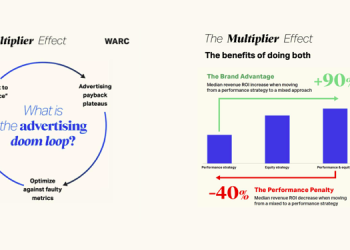WARC, the global authority on advertising and media effectiveness, has today released Marketer’s Toolkit 2020, an annual report outlining the priorities, investment intentions and challenges facing brands in the year ahead with guidance on how to meet them.
Covering five key drivers of change – Society, Technology, Economy, Industry and Policy – this white paper is centred on a survey of almost 800 senior client and agency-side practitioners around the world, with insight from chief marketing officers, global WARC data, industry knowledge and case study examples, and includes pitfalls and recommendations from expert commentators.

David Tiltman
David Tiltman, VP Content, WARC, comments: “This is the ninth annual Marketer’s Toolkit, and it’s bigger than ever. We’ve introduced the new STEIP methodology to give us a comprehensive view of how the industry is evolving, and we’ve combined our new research with CMO interviews and WARC content to give our users a sound guide to the year ahead.”
The STEIP methodology was developed by WARC’s sister brands within the Ascential group of companies. The Marketer’s Toolkit 2020 was created in association with Ascential brands: Cannes Lions, Edge, MediaLink, Money 20/20 and WGSN.
Top insights highlighted in WARC’s Marketer’s Toolkit 2020 are:
Society – The Greta effect
The ongoing rise of conscious consumerism after environmental issues came to the fore in 2019 means brand purpose is evolving into brand activism. The challenge for marketers in 2020 is to respond to environmental challenges in ways that go deep into every part of their organisations, and which are likely to accelerate their response to this trend with particular focus on packaging and supply chain.
Responding to WARC’s Toolkit survey, more than 75% of marketers agree that brands need to take a stand on social issues.

Steve Challouma, Marketing Director, Birds Eye, says: “Issues like plastics in packaging, food waste, nutrition in food, they transcend businesses and brands… they are things that companies should be doing in a broad sense, irrespective of their brand purpose.”
Technology – Context and Connected TV: Reinventing Programmatic
After years of hype about consumer tech, brands appear more cautious about further technology investment – most respondents agreed that brands had over invested in tech at the expense of creativity.
Artificial Intelligence (AI) and payment technology will be key priorities in 2020. Voice will remain a minority pursuit, and 5G is expected to have an impact as an enabler of other technology.
There are big changes in advertising technology, as the limitations of audience-based buying become clear. A renewed focus on context will dovetail with the emergence of connected TV to create new opportunities in programmatic.
50% of respondents either agree or strongly agree that programmatic has “failed to live up to its potential”.
Cheryl Calverley, Chief Marketing Officer, Eve Sleep, says: “Most programmatic is brand-damaging in the way it ends up being executed.I’m really wary of addressable TV. From my point of view, TV is about driving fame, broadly, and fame is around massive collaborative experience. My problem with addressable TV is it massively fragments [audiences].”
Marc Pritchard, Chief Brand Officer, Procter & Gamble, comments: “Context does matter. Different platforms have different usage experiences for the user. What we’re working on is the ability to be able to engage people in every one of those [channels]. That’s a new type of creativity.”
Economy – The pivot back to brand
Brands are re-assessing how they balance their spending in response to a crisis of short-termism, and an over investment in performance marketing. This is set to be a major trend for 2020, though there are significant hurdles to increased brand building investment.
70% of marketers agree that brands have over-invested in performance at the expense of brand-building.
Tariq Hassan, Chief Marketing Officer, Petco, says: “It starts with a leadership point of view. It starts with viewing the word ‘brand building’ as about [more than] what marketing does, but rather about being a ‘brand culture’ as an organisation.”
Bernd Pichler, Chief Marketing Officer, ICONIQ Motors, observes: “I don’t start with choosing the media mix. I start with, “What does the brand stand for?” This has to be very crystal clear, and it has to be very authentic and credible.”
The rapid growth of investment in online video is expected to continue, with Instagram and YouTube set to benefit and a significant number of brands spending on TikTok for the first time.
Search is also expected to be a focus for 2020, with Amazon’s fast-growing advertising business set to benefit alongside Google.
Industry – Building brands in walled gardens
As digital platforms like Amazon and Alibaba grow ever-more influential, marketers are increasingly tasked with building brands within ecosystems over which they have no control, creating a growing reliance on ‘walled gardens’ that combine paid advertising and payment tech or e-commerce fulfilment.
23% of brands plan to increase adspend with Amazon in 2020, with only 3% of marketers anticipating a decrease in investment.
Ivan Pollard, Chief Marketing Officer, General Mills, comments: “It’s not just about driving a sale in e-commerce… How do you make all of your marketing shoppable? The platforms absolutely offer an opportunity to make a sale, to build a brand, and to understand your consumer.”
Experience will remain a buzzword in 2020, as marketers prioritise CX. Creative agencies and consultancies will battle to combine CX with brand thinking.
In-housing of adtech will continue as brands take charge of their data — 34% of respondents say they will be managing more adtech in-house in 2020. In-housing of creativity remains a trend, but a significant minority of brands are putting more work out-of-house.
Gill Zhou, VP of Marketing, Communications and Citizenship, IBM China, notes: “Creativity is still very important, but those who learn about data, statistics and algorithms have become ‘mainstream’ marketers.”
Policy – Privacy-first marketing
Data privacy is both a trend in regulation, and a growing consumer demand. As such, it is one of the most important global themes for marketers in 2020.
The implementation of stronger data protection rights will have significant implications for marketers. The introduction of the California Consumer Privacy Act in January 2020 is already forcing brands and media owners to look again at their data management practices.
While the new regulations change the data landscape, there are opportunities for brands to present themselves as ‘privacy first’ to consumers wary of how their data is being used.
86% of respondents to WARC’s Marketer’s Toolkit survey agree, or strongly agree that “big tech firms should be subject to greater regulation”; 66% of respondents strongly agree that consumers will take greater control of their data in 2020.
Jill Haskin, Chief Marketing Officer, The Hershey Company, says: “For us, a big part of it is “Do we agree with how our partners are using data?” We just want to get a lot more transparency from our partners… How are they keeping [data]?.. We want to have not [just] what’s the legal thing but what we ethically think is right.”
WARC’s Marketer’s Toolkit 2020 is available to download here.
















